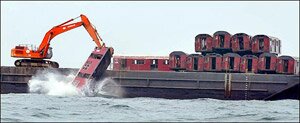July 08, 2003
Subway to the bottom of the sea

Keith Meyers/The New York Times
An old New York City subway car was pushed into the ocean Thursday off Cape May, N.J. A total of 50 cars were added to an artificial reef.
(via BoingBoing)
Subway Cars' Last Stop: Under Sea, Not Ground
By ROBERT HANLEY
APE MAY, N.J., July 3 The hollowed hulks of 50 obsolete New York City subway cars were dumped into the Atlantic Ocean off South Jersey today to begin a watery new life as a haven for fish.
The 50-foot cars, known as Redbirds and long the workhorses of New York's numbered subway lines, became the latest and largest additions to a man-made artificial reef about eight miles off Cape May.
Bradley M. Campbell, New Jersey's environmental commissioner, seemed ecstatic after spending about 90 minutes watching a steam shovel push the dull-red hulks off a barge into about 70 feet of water. They all sank in seconds.
"This is the biggest enhancement of our artificial reef system in one stroke," he said. "This is a win for New Jersey's fishermen, a win for the shore economy and a win for the marine environment because we're enhancing fish habitat."
Mr. Campbell expressed none of the misgivings about asbestos in the old cars that two years ago prompted the state to reject New York City's offer of 650 Redbirds. New York State passed on a similar offer. But New Jersey leaders have since changed their minds, and are eager to use the cars. Over the next two months, four more New Jersey reefs will each receive 50 of the cars.
Recreational and commercial fishermen extolled the subway cars as welcome additions to the artificial reefs, which are piles of old Army tanks and armored personnel carriers, tons of concrete and other construction debris, and scrap steel. The reefs first attract mussels, barnacles and tiny plants. Then sea bass, tautog and flounder come to feed on them. Later, bigger game fish, sometimes tuna and sharks, arrive.
Fishermen say the reefs, like all underwater structures, teem with marine life and become a boon to their hobbies and livelihood.
New York City Transit called ocean disposal the cheapest and easiest way to get rid of the 40-year-old Redbirds.
Yet some jitters about asbestos in the cars linger. New York State, for instance, has passed up a chance to obtain 650 Redbirds for the 11 reefs it has built off Long Island since 1962. The state's Department of Environmental Conservation is still not convinced the asbestos is safe for marine life.
"There's conflicting opinion on whether the cars are safe or desirable," said Matt Burns, a spokesman for the department. "Our first choice is to use more benign materials."
Mr. Campbell, New Jersey's environmental commissioner, said he was satisfied the asbestos would not harm the environment. He said he based his opinion in part on a 2002 study by the federal Environmental Protection Agency that found that ocean disposal of the cars was safe.
That study was issued about a year after New Jersey's acting governor, Donald T. DiFrancesco, rejected the offer of 650 cars for the reefs, citing concerns about the asbestos.
Asked today why the state had reversed its position, Mr. Campbell said, "We took a closer look at the science and we weighed the interests of our saltwater anglers more heavily, and then we struck a more balanced approach."
David Ross, the New York City Transit official overseeing disposal of the Redbirds, said the agency was satisfied the asbestos would not pose problems. "In the water, it doesn't have any health hazard at all," Mr. Ross said as he watched the old cars, one by one, sink into the ocean.
The asbestos, he said, is embedded in an epoxy substance in the floor tiles of the cars and between their exterior and interior walls. The substance was used for insulation, soundproofing and fire retardation. Mr. Ross said New York City Transit was satisfied the epoxy would remain intact, with the asbestos lodged in it, for decades in the ocean.
He said rocks in the ocean naturally contain asbestos. If any ever escapes from the epoxy, he said, it will be little different from asbestos getting loose from ocean rocks.
The Environmental Protection Agency study Mr. Campbell cited dealt with four New York subway cars dumped on an artificial reef off Delaware last year, and five others from Philadelphia's mass transit system placed on an artificial reef off Sea Girt, N.J., in 1990. The study's author, William Muir, an E.P.A. oceanographer, said he studied ocean water in and around the nine cars and found that asbestos levels did not exceed naturally occurring background levels at the two sites.
He also said that laboratory testing he performed on the epoxy from the subway cars shows that it did not dissolve, convincing him that there was little likelihood it would break up in the ocean.
The cars dumped offshore today were stripped of all doors, windows, hand grips, signs, wheels, engines, and oil and grease, Mr. Ross said.
Nearly 1,000 of the Redbirds have already been dumped in the last two years on artificial reefs off four other Atlantic Coast states. Delaware got 567, while 200 went to South Carolina, 150 to Virginia and 50 to Georgia, Mr. Ross said.
New York City Transit has only about 100 Redbirds left, Mr. Ross said, and they will go to museums or serve as work trains in the subway system. Cleaning and ocean disposal of the 1,200 cars will cost New York City Transit about $16 million, he said, half the estimated cost of cutting up the cars and burying them.
Posted by glenn at July 8, 2003 09:49 AM | TrackBack77
Posted by: at December 4, 2003 01:26 AM